Spanish Water Dog Breed Information
The Spanish Water Dog, or SWD, is an ancient canine breed with a long history on the Iberian Peninsula. This herding dog has served as a shepherd, waterfowl hunter, and family protector. This canine is known for its allergy-friendly coat, which forms cords and resembles fleece, and sharp mind. The Spanish Water Dog is versatile, excelling in tasks from hard work to being an affectionate family dog.
People often lack knowledge about the specific needs and quirks of a Spanish Water Dog puppy. Potential owners should carefully approach a reputable breeder and consider these points before getting a Spanish Water Dog puppy. By understanding the breed’s past and present challenges, we can comprehend the entire history of the Spanish Water Dog, aiding the Spanish Water Dog Club in promoting and protecting the breed. It prompts us to consider how the Spanish Water Dog might fit into the dynamic spectrum of modern pet ownership.
Key Takeaways
- The Spanish Water Dog is a medium-sized breed known for its agility, intelligence, and protective nature.
- Originating from the Iberian Peninsula, this canine breed typically has a lifespan of 12 to 14 years.
- The SWD breed is incredibly versatile, excelling particularly in herding and retrieving tasks.
- Spanish Water Dogs, with their sturdy, medium build, sport curly fur that forms cords and are available in a variety of colors.
Quick Facts
The Spanish Water Dog, locally known as Perro de Agua Español, captures attention with its unique wooly curls that form cords. This medium-sized member of the Herding Group, the Spanish Water Dog, has a life expectancy of 12 to 14 years. Male Spanish Water Dog puppies usually grow to be 17.5-19.75 inches tall and weigh between 40-49 pounds. Female Spanish Water Dog puppies are slightly smaller, growing to 15.75-18 inches in height and usually weighing between 31-40 pounds. Their fur doesn’t just form cords for show – it acts as a natural barrier that protects them during herding tasks or retrieving birds from the water.
These intelligent and devoted dogs are naturally inclined to guard, making them great family dogs. However, early socialization and a firm hand in dog training are necessary to avoid behavioral problems.
With a lot of energy to burn, the Spanish Water Dog thrives in dog sports, which keeps them fit and mentally sharp.
Spanish Water Dog Breed Pictures
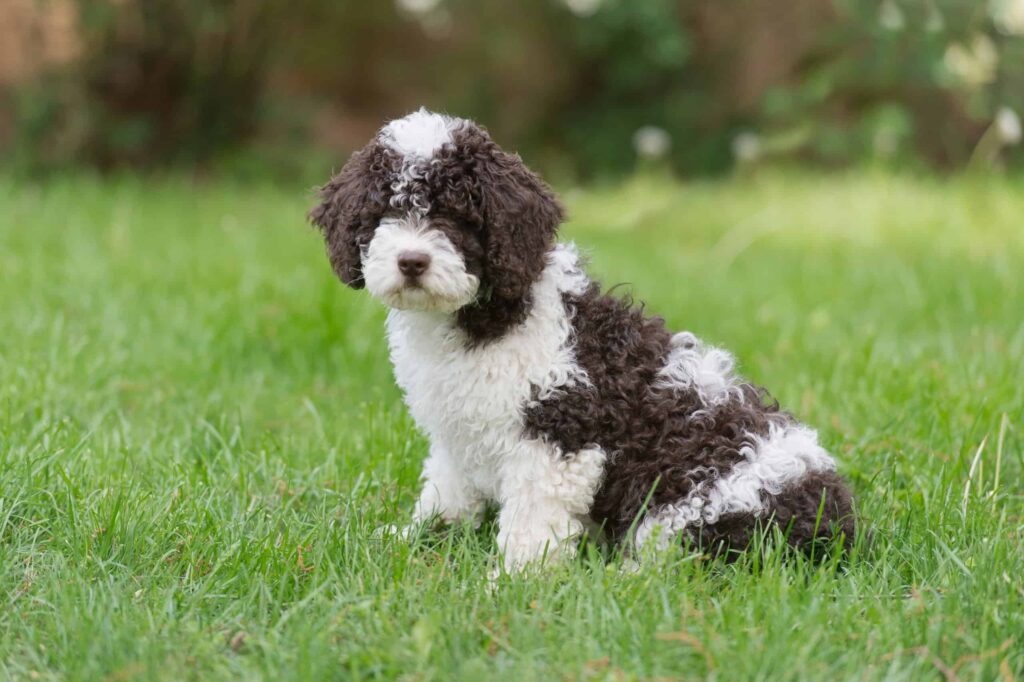
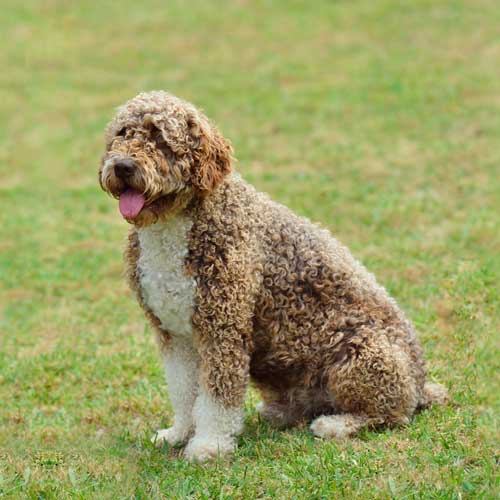
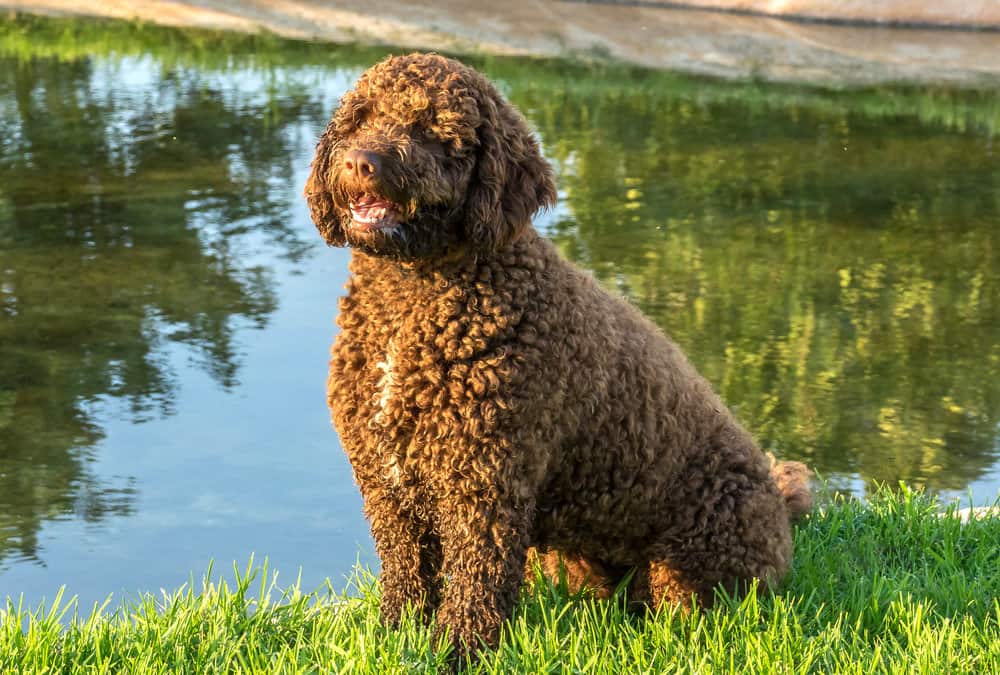
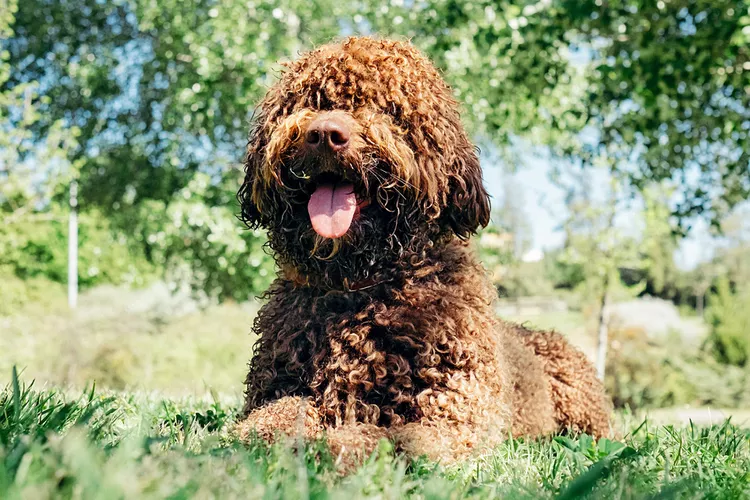
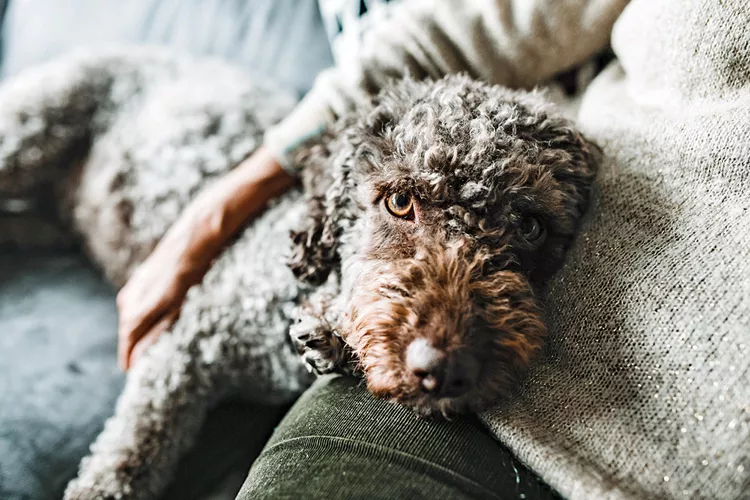
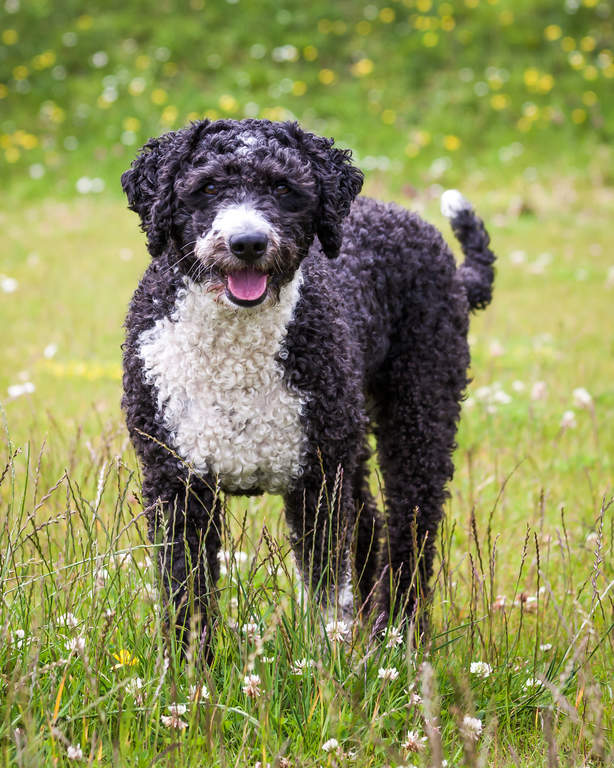
Overview
Originating from the Iberian Peninsula, the Spanish Water Dog is revered for its multifaceted role as a herder and retriever, displaying a combination of agility, intelligence, and a protective nature highly valued by enthusiasts and professionals.
This medium-sized breed, ranking 163 out of 200 in AKC breed popularity, is characterized by its distinctive wooly curls and athletic build, which facilitate its herding and waterfowl retrieving capabilities.
The breed’s contribution to enhancing physical and mental well-being is substantiated by its ability to provide security, reduce stress, and alleviate loneliness.
The AKC underscores the breed’s distinctive appearance and herding instinct, advocating against trimming the coat for aesthetic purposes, and offers a compendium of resources for owners to optimize the breed’s potential through training and socialization.
Breed Hallmarks
The Spanish Water Dog stands out due to its versatile abilities. This breed is recognized for being both a capable herder and a retriever. Here’s a quick rundown of what makes them unique:
| Physical Attribute | Behavioral Trait |
|---|---|
| Sturdy, medium size | Devoted and warm |
| Curly fur | Instinctive herding skills |
| Variety of fur colors | Lively and smart |
The curly fur of the Spanish Water Dog isn’t just for looks; it’s practical, shielding the dog from water and harsh weather. Their coat care is straightforward but needs regular professional attention to stay healthy. These dogs are emotionally bonded to their owners and need plenty of exercise and mental challenges to thrive in home and work settings.
Their distinctive curls require specific grooming practices to keep them in top shape. Engagement and mental challenges are crucial for the Spanish Water Dog’s well-being. They fit best with active families or those with a job that keeps them moving.
History of the Spanish Water Dog Breed
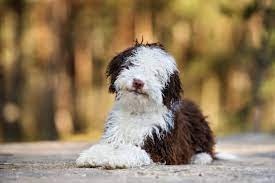
The history of the Spanish Water Dog is a fascinating journey through time and culture. This breed’s roots are deeply woven into Spain’s past, reflecting the country’s:
- The breed’s lineage includes African influences and a solid connection to the Spanish landscape.
- Traditionally, this dog has been a jack-of-all-trades, proficient in herding, retrieving, and assisting fishermen.
- Originating from various parts of Spain, each area has left its mark on the breed, giving it unique skills and traits.
The Spanish Water Dog has a rich heritage mirrors the evolution of Spain’s society and agriculture. Its ancestors may have come from Africa, adapting seamlessly to the Spanish climate and terrain. In its past, this breed has been an all-rounder, involved in herding, hunting, and aiding in fishing – a true testament to its smarts and adaptability. The dog’s origins span different Spanish regions, influencing its abilities and personality.
Ancestral Lineage
Researching the history of the Spanish Water Dog shows that this breed has deep roots in Spain’s countryside. Historical documents from 1100 A.D. suggest that these dogs may share ancestry with African species. Spanish Water Dogs were versatile farm workers, skilled in managing livestock, hunting, and performing water-based tasks. These abilities reflect the breed’s adaptability.
The physical characteristics of the Spanish Water Dog, such as its unique curly fur and sturdy build, show that they were bred for practicality. In the past, they were known as Perro Turco or Turco Andaluz, which points to their diverse genetic background. This breed typically has a medium size, a solid yet graceful head, and expressive eyes. These features were intentionally developed for the dogs to work effectively in the varied landscapes and weather conditions across the Iberian Peninsula.
Historical Roles
Throughout their long presence in Spain, Spanish Water Dogs have played crucial roles in various activities, showcasing their diverse skills and importance in different parts of the country.
These dogs, also known as Perro de Agua Español, have been a part of the rural landscape for over 800 years, performing critical tasks in both land and water. Records dating back to 1100 A.D. reveal their existence and expertise in herding and aquatic work.
Their African roots, likely brought over by North African people or through Turkish trade, contributed to their ability to thrive in Spain’s varied environments. Known for their protective nature, these dogs were also trusted as reliable guardians.
Today, the Water Dog Club maintains the breed’s traditions, underlining the Spanish Water Dog’s ongoing importance in farming and home life.
Geographic Beginnings
The Spanish Water Dog has been an iconic part of Spain’s countryside for a long time. This dog breed’s history can be traced back to at least 1100 A.D. They are deeply connected with the area’s traditional farming activities. These dogs were carefully bred to perform specific tasks. They herded animals in the countryside and helped with fishing along the coast.
Their genetic history may include ancestors from Africa, perhaps brought over by North African settlers or through sea trade with Turkish merchants. The Spanish Water Dog shares similarities with its relative, the Portuguese Water Dog. Both breeds have evolved to thrive in the Mediterranean region’s watery landscapes.
Stature and Build
The Spanish Water Dog boasts a harmonious build integral to its functionality as a versatile working breed. An analytical examination of their physique reveals a balance between strength and agility, reflected in the breed’s well-defined musculature and solid bone structure. Considering these characteristics, the following points warrant detailed discussion:
- Typical Body Dimensions: Assessing the breed’s standard measurements in height and length to understand its square or slightly rectangular profile.
- Muscle and Bone Structure: Evaluating the robustness and composition of the breed’s musculoskeletal framework.
- Weight Range: Document the average mass of males and females to gauge the breed’s size category and physical condition.
Typical Body Dimensions
Spanish Water Dogs are known for their balance of power and skill. Male dogs generally have a height of 44 to 50 centimeters at the withers and weigh between 18 and 22 kilograms. Females are a bit smaller, usually standing at 40 to 45 centimeters tall and weighing 14 to 18 kilograms. When converted to inches, males reach about 17.5 to 19.75 inches at the shoulders, with females measuring 15.75 to 18 inches. These differences between the sexes are pretty standard.
These dogs have slightly longer bodies than tall ones, giving them a sturdy and active profile. Their bone structure and muscle distribution are designed for both strength and stamina. This makes them excellent for tasks like herding and jobs that involve water.
Muscle and Bone Structure
Spanish Water Dogs are medium-sized and muscular, designed for land and water activities. Their body is slightly longer than tall, making their center of gravity ideal for the herding and swimming tasks they were bred for. Their bones and muscles show they were made for sustained activity and power.
However, these dogs can be prone to hip dysplasia, a hip joint issue that affects their mobility. Genetic factors cause it, and can be worsened by rapid growth or too much stress on their bones while young.
To keep these dogs healthy, breeders must be careful, and owners should watch their dogs’ growth and exercise.
Weight Range
Spanish Water Dogs are medium-sized, with females weighing between 31 and 49 pounds and males weighing a bit more at 40 to 49 pounds. Their build is solid and athletic, which helps them in their traditional jobs of herding and retrieving. They should be neither too heavy nor too light; the right weight helps them stay active and fit. These dogs need to avoid getting overweight.
Owners should keep them on a strict diet and regular exercise schedule. This keeps them healthy, avoids any extra health issues, and keeps them doing the jobs they’re bred for. Staying at the right weight also helps Spanish Water Dogs live longer.
Athleticism and Agility
The Spanish Water Dog is known for its agility and muscular build, making it excellent for activities that need fast reflexes and stamina. These medium-sized dogs are sturdy with a slightly longer body, ideal for a life filled with physical exercise.
Their build, which includes a powerful, refined head and soulful eyes, showcases their versatility as athletes. They have ears shaped like triangles, set at a moderate height, and a unique curly coat left natural, all supporting their agility.
Spanish Water Dogs shine in competitive dog sports such as agility courses and flyball tournaments. Their combination of physical qualities and a natural tendency to be loyal and protective makes them great at complex tasks that require both body and brain.
Breed Standard Proportions
The Spanish Water Dog is well-balanced, slightly longer than tall, which gives it stability and strength. These traits are vital for its roles in herding and retrieving waterfowl. According to the American Kennel Club standards, male dogs stand between 17.5 and 19.75 inches and weigh 40-49 pounds. Female dogs are a bit smaller, with heights of 15.75-18 inches and weights ranging from 31-40 pounds.
Their athletic build is perfect for their active lifestyle, and their heads feature a gentle curve with wide-set, expressive eyes. Their coat is known for its curly texture and is kept natural and unclipped to preserve its rustic look. Notable features of the breed include a tail that is often naturally short and skin pigmentation that matches the darkest coat color. These features show how the species has evolved for a mix of functionality and endurance.
Temperament and Character Traits
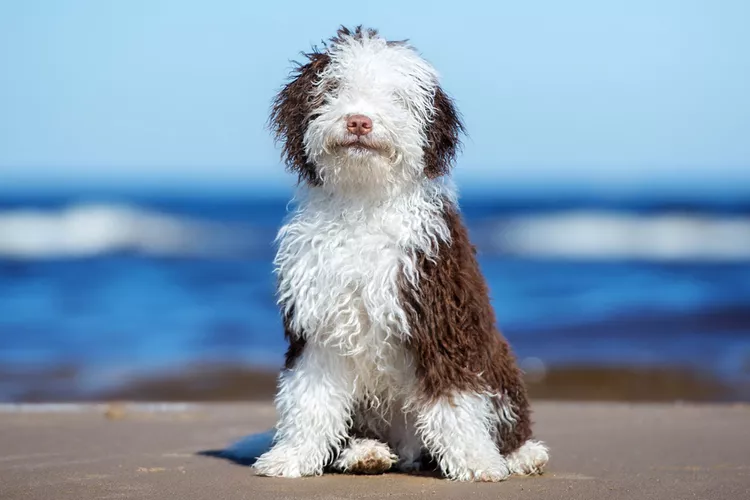
The Spanish Water Dog is a multifaceted breed shaped by generations of selective breeding for particular roles. These dogs are known for the following characteristics:
- Loyal Family Companionship: They form strong bonds with their families, which makes them highly reliable. This loyalty creates a safe and protective atmosphere at home.
- Intelligent Work Ethic: Spanish Water Dogs are smart and can solve problems. They learn new commands quickly, making them efficient workers.
- Energetic Playfulness: They are naturally active and have plenty of stamina. This means they need consistent exercise to stay healthy and happy.
These dogs are not just pets; they become integral to the family. Their intelligence makes them great at tasks, and their playful nature keeps everyone entertained. Regular exercise is critical to managing their energy levels.
Loyal Family Companions
Spanish Water Dogs have earned a reputation for their intense loyalty and make excellent, loving family pets. These dogs are naturally protective of their home and loved ones, which makes them excellent watchdogs. They often form a special connection with one person in the family, although they show affection to everyone.
Their need for exercise and mental challenges make them active in any household.
Intelligent Work Ethic
Spanish Water Dogs are naturally diligent and skilled at solving problems. Their intelligence and solid herding instincts contribute to their impressive work abilities. These dogs have a genetic predisposition to be industrious, which helps them shine in jobs that demand consistent training and mental involvement. They can understand complex instructions and are versatile enough to handle various tasks, which is why they’re good at dog sports and similar demanding activities.
A well-defined daily routine and a clear understanding of their position in the family help Spanish Water Dogs learn effectively. They might start misbehaving if they don’t get enough mental and physical exercise. Giving them tasks that challenge their brains and bodies is essential to keep them happy and well-behaved.
Energetic Playfulness
Building on their strong work ethic, Spanish Water Dogs are known for their lively playfulness. This quality is as essential as their energy, keeping them happy and adaptable to different jobs.
These dogs are full of life and love to stay active with various physical activities. Their natural athletic abilities make them great at dog sports, giving them the necessary exercise and mental challenges.
Their love for playing also makes them better at jobs like herding and retrieving, where they need to move quickly and respond to commands. Giving them lots of chances to play and exercise is essential. This helps them use up their energy in a good way and keeps them healthy and happy.
Instinctual Protective Nature
The protective instincts of Spanish Water Dogs are evident in their constant alertness and strong desire to safeguard their home and loved ones. Originating from their past as shepherd dogs, these animals naturally are inclined to oversee their household. Introducing them to various social situations early on, especially with young kids and other animals, is critical to prevent them from becoming overly guarded. This approach helps them adapt well to living with people.
Spanish Water Dogs are not only protective but also highly intelligent and loving. They are excellent at keeping homes safe and participating in family life. These traits make them well-rounded pets that fit into many different family settings.
Adaptable Learning Abilities
Spanish Water Dogs are highly intelligent and eager to learn, which makes them excel at picking up new tasks. Their smartness makes training them not only easy but also practical. They respond well to instructions because of their sharp minds.
These dogs also have a lot of energy and athleticism, which means they’re great at various activities and dog sports. However, starting socializing early is vital because they were originally bred for herding and guarding. This way, they’ll be friendly and well-behaved in different environments.
Their loyalty and protective nature make them dependable protectors and furry family members.
Wellness Considerations
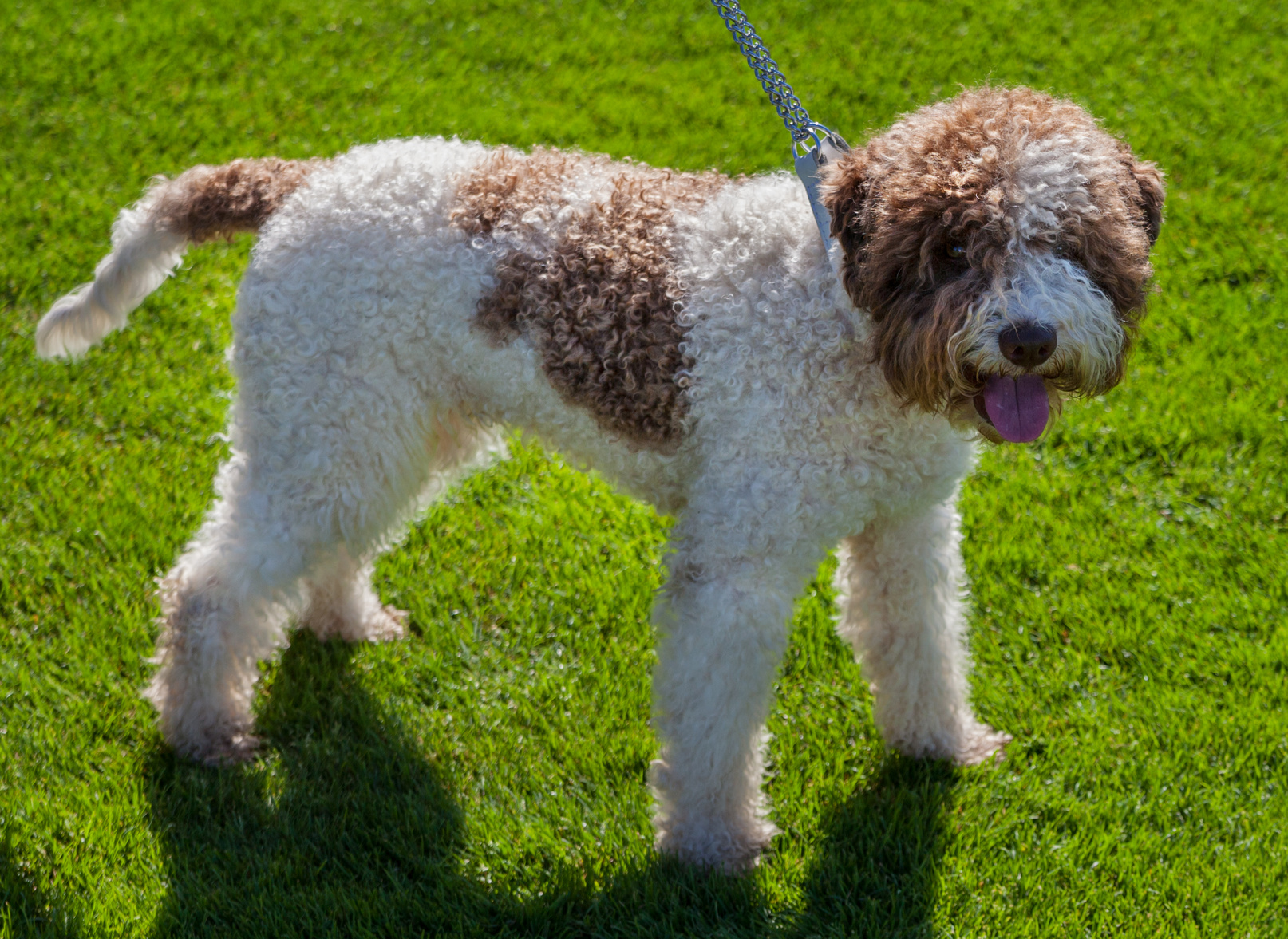
The health and longevity of the Spanish Water Dog are significantly influenced by their diet and nutrition, exercise routines, and genetic predispositions to certain medical conditions. An analytical approach to their wellness should consider the following:
- The specific caloric and nutritional requirements are tailored to support their active lifestyle and metabolic needs.
- They structured physical activity regimes that fulfill their instinctual drives and mitigate the risks of obesity and associated comorbidities.
- Proactive surveillance for hereditary health issues through regular veterinary screenings and implementing preventive healthcare measures.
Diet and Nutrition
To keep a Spanish Water Dog healthy and full of life, it is essential to give them food that suits medium-sized dogs who are very active. Their diet must have all the necessary nutrients to match their lively nature. It’s best to measure their food carefully and feed them twice daily to avoid being overweight.
Talking to a vet can help create a meal plan for their needs, keeping them in good shape. Regular exercise is also crucial, with at least an hour of physical and mental activity daily to meet their energy requirements. Participating in dog sports improves their fitness and keeps their sharp minds engaged.
Exercise Requirements
For Spanish Water Dogs, regular physical activity is vital to their well-being. They need exercise to stay healthy and to keep their sharp minds busy. These dogs have a lot of energy and smarts, so they need to do things that make them think and move to avoid getting into trouble from being bored or too hyper.
Agility training and flyball are great ways to use their natural quickness and smarts, which help keep their heart healthy and muscles strong. These sports also make their brains work hard and keep learning fun.
Having a consistent schedule with someone who can lead them well is crucial. This helps them use their natural herding skills well and keeps their body and mind in check.
Common Health Issues
Spanish Water Dogs are typically healthy and can live from 12 to 14 years. However, they may inherit health issues like hip dysplasia, skin allergies, and endocrine disorders. These conditions need close attention and treatment.
Hip dysplasia, where the hip joint forms improperly, is common and can lead to arthritis and discomfort. Skin reactions from allergies may require changes in diet and living conditions.
Hormonal imbalances from endocrine disorders like hypothyroidism must be managed with medication. Eye problems in these dogs can range from mild to severe, like progressive retinal atrophy, and should be checked by a vet regularly.
Neuroaxonal Dystrophy is a severe neurological disease that affects coordination and demands early detection and ongoing care.
Grooming Needs and Maintenance
Maintaining the distinct coat of the Spanish Water Dog is essential for their overall health. A careful grooming plan is vital to keep their coat and skin. Here’s what you need to do:
- Coat Care: Brushing the dog’s coat every two weeks is recommended. This helps to untangle any knots and check the skin for any issues. It’s also important to keep trimming to a minimum, as this breed has specific grooming standards.
- Cleanliness: Regular ear cleaning and teeth care are vital. These practices help to ward off infections and dental problems, which can lead to more severe health issues.
- Bathing and Nails: Find a balance for how often you bathe your dog to maintain the natural oils in their coat. Also, trim their nails monthly to support proper walking and prevent paw problems.
In short, the Spanish Water Dog needs a thoughtful grooming routine. Regular brushing, cleaning, and nail care will keep them healthy and happy. Remember, each step is vital for your dog’s well-being and appearance.
Coat Characteristics
The Spanish Water Dog is known for its distinctive, tightly curled coat. Owners should follow a particular grooming routine to keep it healthy and looking its best. This dog’s fur is excellent for land and water, helping it swim and work in different settings. If the coat grows too long, it can form into cords, so regular cleaning is needed to stop tangles and knots.
Professional grooming should be done two to three times a year, even though changing the dog’s look just for style is not recommended. Regular washing and grooming help keep the coat in good condition. The breed is also suitable for people with allergies, as it doesn’t shed much. Caring for the skin will keep the dog’s health in check and maintain its rugged, natural beauty.
Regular Grooming Routine
Regular grooming is essential for Spanish Water Dogs to maintain a healthy and attractive appearance. This involves following a consistent grooming routine and brushing their curly coats to prevent mats and tangles. If left unaddressed, these mats can lead to skin issues and infections. Professional groomers should be visited about two or three times a year to maintain the dog’s natural coat condition, which is particularly important for working dogs. In addition to coat care, regular grooming practices should include cleaning the dog’s ears, trimming their nails, and keeping their teeth clean to support overall health. Lastly, scheduling regular vet visits, ensuring vaccinations are current, and practicing parasite prevention measures to ensure the dog’s well-being are crucial.
Trimming and Shaping
Properly grooming a Spanish Water Dog involves carefully maintaining their curly coat while considering their needs. Their unique coat made up of tight curls, acts as a shield and suits their traditional roles. Keeping this coat intact is necessary for the dog’s skin to stay clean and healthy.
Brushing their hair often is essential to avoid tangles that can trap dirt and cause infections. When trimming, it’s more about the dog’s health than looks. This means cleaning around the ears, keeping the paws tidy, and ensuring the dog can see well. This practical grooming approach is about keeping the dog healthy and avoiding unnecessary styling.
Proper grooming ensures a Spanish Water Dog’s coat serves its purpose without compromising health. Regular brushing is critical to preventing painful mats that can lead to skin problems. When it comes to trimming, it’s all about the dog’s well-being. Clearing the ears, cutting around the paws, and keeping the face neat are all essential. This focus on practical care over appearance highlights the importance of knowing what’s best for each breed.
Bathing Frequency
Regular grooming is vital for the health of a Spanish Water Dog’s coat. To keep their coat in top condition, it’s best to bath them every 6 to 8 weeks. This helps protect their natural curls and prevents their fur from matting. A mild dog shampoo for curly coats will help keep their skin healthy. Before washing, brushing their coat thoroughly is vital to avoid any knots or mats. After bathing, make sure to dry them nicely to stop skin problems and more matting from happening. As part of their care, you should also regularly trim the hair on their paw pads, ears, and nails.
When washing your Spanish Water Dog, choose a shampoo that’s kind to their curls. The right shampoo not only cleans but also maintains the coat’s health. They brushed before a bath stops mats, making washing more accessible. Drying them entirely after bathing is essential to keeping their skin healthy. Along with their regular baths, don’t forget to trim the hair on their paws, ears, and nails to keep them comfortable and tidy.
Ear and Dental Care
Ensuring the optimal health of a Spanish Water Dog’s ears and teeth is crucial. Regular cleaning and inspection of the ears can prevent infections, while consistent dental care can thwart plaque and gum disease buildup.
An analytical approach to ear care involves routine examination. This helps identify abnormal secretion or inflammation, indicating potential health concerns. To mitigate the risk of otitis, the aural environment should be kept dry and clear of debris.
Dental hygiene practices necessitate the use of canine-specific toothpaste and toothbrushes. These tools help remove plaque and decrease the likelihood of periodontal disease.
Professional groomers can offer precise guidance on these procedures. They emphasize the importance of early habituation to these maintenance routines. This helps to foster acceptance and cooperation from the dog throughout its life.
Nutritional Requirements
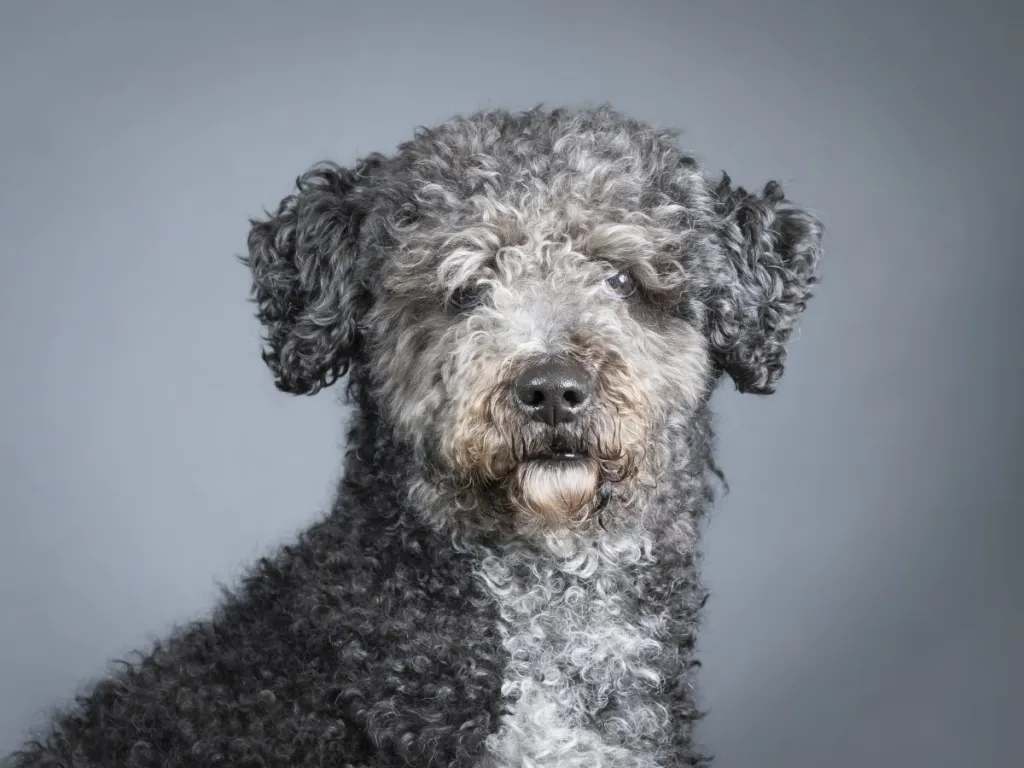
Maintaining the health and energy of Spanish Water Dogs hinges on proper nutrition. Their diet must be scientifically formulated with balanced diet essentials. Mixing the right amounts of proteins, fats, and carbohydrates with vitamins and minerals for this breed’s unique needs is critical.
Special dietary considerations are also crucial for Spanish Water Dogs. Recognize any food sensitivities typical of this breed and make necessary diet changes to avoid health issues.
Feeding schedule tips are crucial when it comes to Spanish Water Dogs. Plan meal times and portions to match the dog’s natural metabolism and activity level.
When feeding Spanish Water Dogs, it’s vital to understand their specific nutritional needs. A well-planned diet supports their active lifestyle and prevents common health problems. Keep meal schedules consistent, and adjust portions according to the dog’s daily exercise.
Balanced Diet Essentials
Spanish Water Dogs thrive on a diet packed with high-quality proteins, vital fats, carbs, and vitamins and minerals. Their active lifestyle means they need food that keeps up with their energy levels.
Proteins should come from top-quality meats to help keep their muscles strong and aid recovery. It’s also crucial for these dogs to get plenty of healthy fats, like omega fatty acids, for a shiny coat and healthy skin.
Carbs are the fuel that powers their day-to-day play and exercise. But it’s also essential to watch how much they eat to avoid weight gain, a common issue for pets.
Always make sure they have access to clean water.
Sometimes, supplements like fish oil can be good for them, but it’s best to talk to a vet first. They can advise on whether your dog needs supplements and the right amount to give them.
Special Dietary Considerations
Understanding the dietary needs of Spanish Water Dogs is vital to keeping them healthy. These energetic, mid-sized dogs need a diet that supports their activity levels without leading to weight gain. It’s best to feed them twice a day with precise portions.
Working with a veterinarian to create a diet plan that considers each dog’s health is essential. Spanish Water Dogs often face hip dysplasia, allergies, hormonal, eye, nerve, and stomach problems. Their diet should provide energy and help prevent and manage these health conditions.
Stay on top of their health with regular vet visits and adjust their diet as needed.
Feeding Schedule Tips
A regular feeding time can do wonders for a Spanish Water Dog’s health and alertness. Setting up a feeding pattern helps control the dog’s metabolism, which means their energy levels stay even all day. Experts recommend two well-rounded meals each day for these medium-sized, active dogs.
It’s important to pick high-quality dog food made for medium-sized breeds to meet their specific dietary needs. Getting the portion size right is crucial and should be adjusted according to the dog’s activity level, age, and metabolism to prevent overfeeding.
Try adding some puzzles to their mealtime to keep their sharp minds busy.
Always check with your vet to tailor a diet for your dog’s health and keep them in the best shape.
Regular feeding schedules, high-quality food, and puzzle feeders can help maintain your dog’s well-being.

